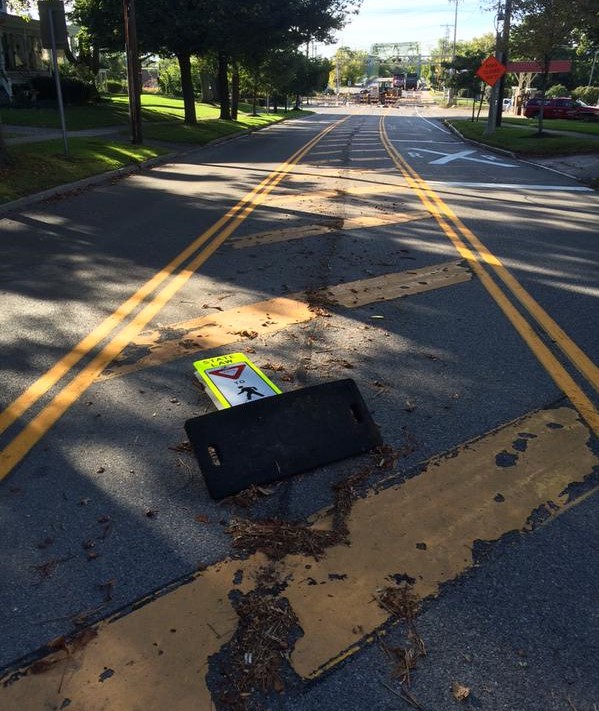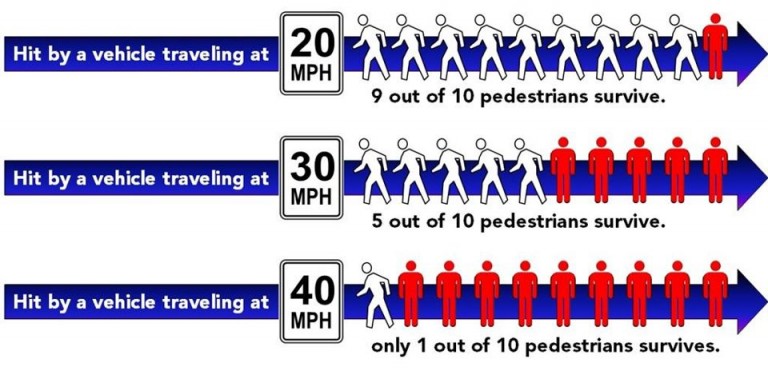
[Squashed pedestrian sign at Sutherland & Monroe crossing]
At the community meeting about the Active Transportation Plan last Saturday, residents who live along Jefferson Road near Sunset said traffic regularly zips by at 45 and 50 mph heading toward Clover St. Many of them don’t even bother sitting on their porches because it’s too darn loud. The village’s traffic calming study clocked the average speed outbound on Monroe between Main and the village line (where 20K vehicles traverse each day) at 38 mph, with 85% of the drivers going 44 mph.
Think 40 mph is reasonable? Let’s break that down.
The higher the vehicle speed, the greater the risk to a pedestrian or cyclist. Especially when speeds are above 30 mph. A pedestrian has a 90% chance of survival if he or she is hit by a car going 20 mph. At 40 mph? Only a 10% chance. That risk is heightened if that pedestrian is a child or older person.
Let’s take it to a scarier place and examine why it’s so much deadlier at speeds above 30mph:The human body can only take so much. Our organs, bones, skin and skull are not designed to land unbroken and unbattered after an impact with a vehicle at high speeds. And 30 mph is that threshold.
“The laws of physics and human anatomy translate to 30 mph being far deadlier than 25 mph. The difference in velocity translates to the car lifting pedestrians off the ground, and creating traumatic impacts against vital areas like the head.”
According to AAA, the median impact speed for pedestrian fatalities (not injuries) in this country is 35 mph, which makes sense given that our bodies just can’t take higher speeds. Unfortunately, we know 35 mph and higher are speeds common on our village streets.
A 13 year-old was injured in a recent hit and run on Main St. It was an alarming reminder that cars and drivers rule our village streets. Had that crash occurred on State, Monroe or Jefferson where speeds are much higher, the outcome would have been even more tragic.
Okay, okay. But I mostly drive. What’s in it for me?
Driving at more cautious speeds make streets safer for drivers too. Why? You have more reaction time as a driver. The higher your speed, the more time you need to react. If you are driving 40 mph and something appears in the road 100 feet ahead, you will crash into it still going 36 mph. No matter what the hazard is ahead (another car, trash can, pedestrian, child on a bike, deer…), you need 235 feet to stop if you are going 40 mph. At 25 mph? You can come to a full stop within 100 feet.
The more reaction time we as drivers have, the less likely we are to have a crash in the first place. And if a crash does happen, the severity will be much less (especially if there is a pedestrian or cyclist involved.)
Benefits to the community
How fast we drive through our village has a ripple effect beyond our own safety and those near us on the street.
Calmer traffic encourages more people to be out and about on their community streets. That means more people walking and biking to their neighbors’ and friends’ houses, more people supporting local businesses, more people getting more exercise and less fossil fuel being consumed to do those things.
- People notice local businesses more when they aren’t speeding by (and especially if they are walking and biking by).
- More people out engaging in their communities on the streets helps reduce crime
- Reduced speeds are better for property values.
- Safer streets help people foster everyday social connections, which helps increase levels of happiness and improves quality of life.
- People are healthier when they walk and bike more. In fact, people who live in walkable communities weigh 6-10 pounds less than those who live in communities designed for driving.
- More people walking and biking reduces public health costs. Obesity and other health issues tied to the sedentary lifestyles of its residents costs the state of New York billions annually. And traffic crashes cost the US economy more than $200B each year.
How fast we drive through our village streets does matter. It matters a lot. It matters for all of the people who live, work and play around here — regardless of whether they walk, roll, cycle or drive. And it impacts the livability of our community. Driving is a huge responsibility and each of us who drives is part of the solution to safer streets in our village.
There is currently a bill in the NYS Senate that authorizes the Village to lower the speed limit to 25 mph. This alone won’t make our streets safer, but it is an important part of the solution that also involves better design, enforcement and education.


Pingback: Speeding in the Village: The Numbers – Walk Bike Pittsford